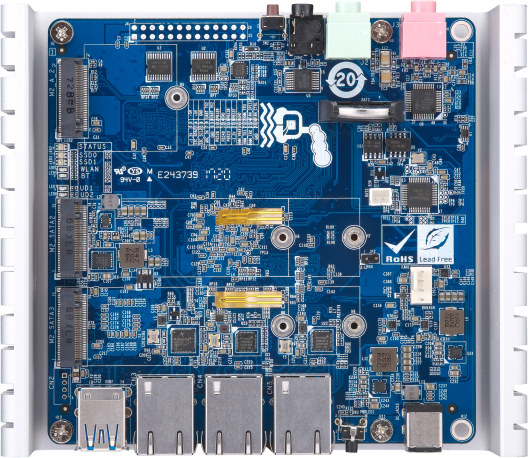We first had a glance at QNAP QBoat Sunny at CES 2017. At the time, QNAP IoT development board was powered by an Intel AnyWAN GRX750 dual core Atom based processor with 2GB RAM, 4GB flash, three Gigabit Ethernet ports, some mSATA slot and so on.
The company has now officially announced the board, but with a twist, as the Intel processor has been replaced by Annapurna Labs (now part of Amazon) AL-314 quad core ARM Cortex-15 processor instead, and left most of the other features pretty much unchanged.
 QBoard Sunny board specifications:
QBoard Sunny board specifications:
- Processor – Annapurna Labs AL-314 quad core ARM Cortex-15 processor up to 1.7 GHz
- System Memory – 2GB DDR3L
- Storage – 512MB NAND flash, 2x M.2 2260/2280 SATA slots for SSDs (Key M)
- Network connectivity – 3x Gigabit Ethernet
- USB – 2x USB 3.1 Gen1 ports
- Audio – 3.5mm audio out jack, 3.5mm audio in jack
- Expansion
- 1x M.2 Key A 2230 for Wi-Fi/Bluetooth
- 40-pin connector, for I2C, UART, SPI, SDIO, GPIO
- Misc – Debug console via 3.5mm jack; RTC battery; status and user LEDs; power & system reset buttons; pin connector for 4-wire fan
- Power – 12V/3A
- Power Consumption – 9.49 Watts with SSD idle; 13.31 Watts in operation
- Dimensions – 144 x 126 x 33.5 mm (with heatsink base)
- Weight – 490 grams
- Environmental Conditions – 0 to 35C, 5 to 95%, non-condensing, wet bulb temperature: 27C
The board runs QTS Lite 4.3.3 embedded Linux operating system, supports features like Wake on LAN, scheduled power on/off, and automatic power on after power recovery.
Annapurna Labs does not appear to be the kind of company that release SoC documentation publicly, and I really wonder why they even bothered to setup a website. They (or somebody else) did add support to Alpine SoCs in Linux 4.6, but I’d still assume you’d have to relies on QNAP for the OS and low level software, and just take care of the application on top, praying the lower level feature(s) you need is/are well supported.
Qboat Sunny ships with an Ethernet cable, a quick installation guide, a 36W AC adapter and power cord, a wall mount kit, an M.2 screw kit, and two M.2 SSD heatsinks. The promo video below explains why you may want to use the board in your (IoT) projects, for example using it instead of public cloud services to save money.
The company claims the board is available now at an affordable price. The only thing is I’ve not been able to find the price… At CES 2017, there was talk about a $100 to $120 with the Intel version. [Update: MSRP is $169/€159]. More details may be found on the product page.
Thanks to TLS for the tip.

Jean-Luc started CNX Software in 2010 as a part-time endeavor, before quitting his job as a software engineering manager, and starting to write daily news, and reviews full time later in 2011.
Support CNX Software! Donate via cryptocurrencies, become a Patron on Patreon, or purchase goods on Amazon or Aliexpress





